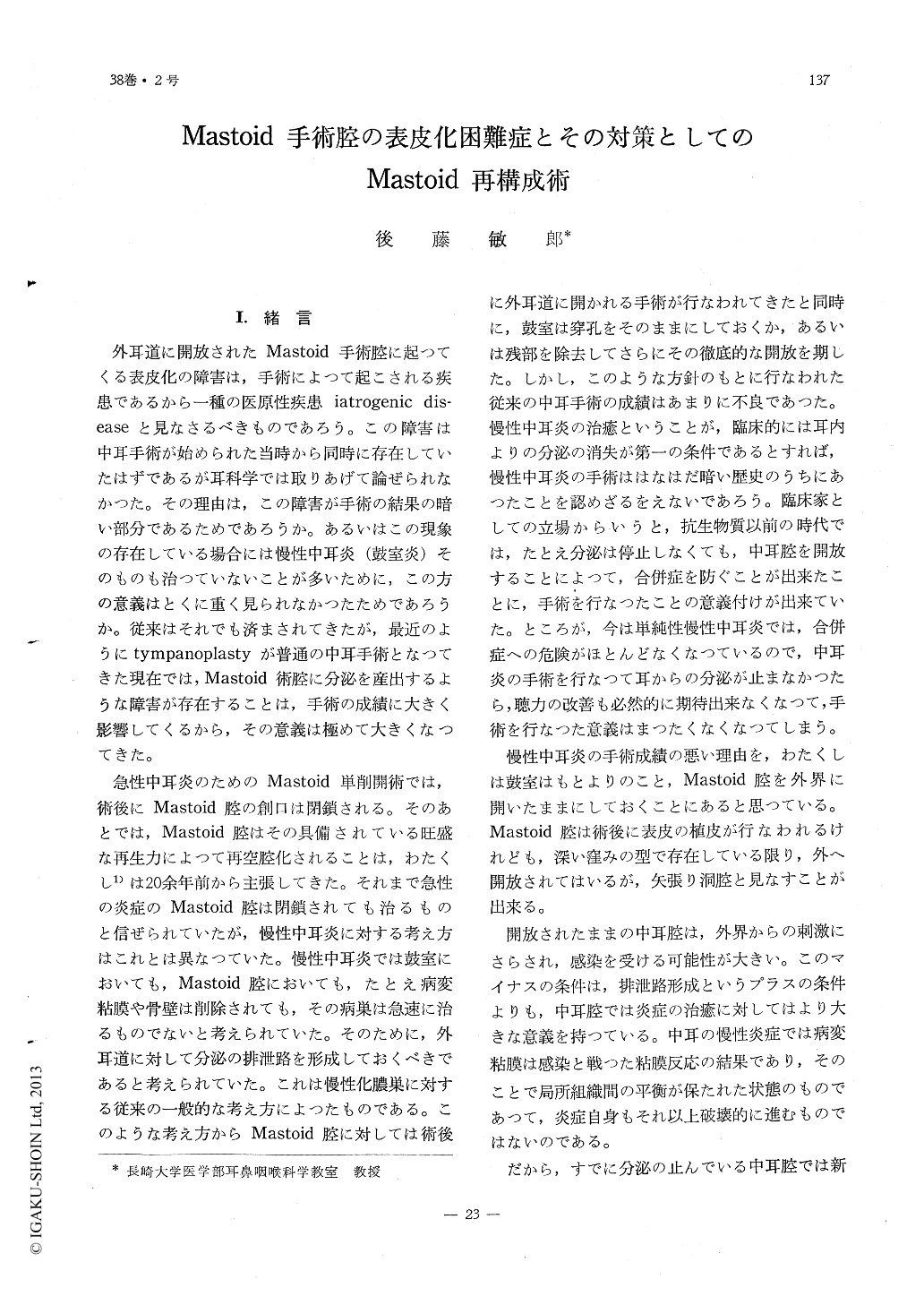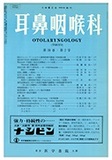Japanese
English
- 有料閲覧
- Abstract 文献概要
- 1ページ目 Look Inside
Ⅰ.緒言
外耳道に開放されたMastoid手術腔に起つてくる表皮化の障害は,手術によつて起こされる疾患であるから一種の医原性疾患iatrogenic dis-easeと見なさるべきものであろう。この障害は中耳手術が始められた当時から同時に存在していたはずであるが耳科学では取りあげて論ぜられなかつた。その理由は,この障害が手術の結果の暗い部分であるためであろうか。あるいはこの現象の存在している場合には慢性中耳炎(鼓室炎)そのものも治つていないことが多いために,この方の意義はとくに重く見られなかつたためであろうか。従来はそれでも済まされてきたが,最近のようにtympanoplastyが普通の中耳手術となつてきた現在では,Mastoid術腔に分泌を産出するような障害が存在することは,手術の成績に大きく影響してくるから,その意義は極めて大きくなつてきた。
急性中耳炎のためのMastoid単削開術では,術後にMastoid腔の創口は閉鎖される。そのあとでは,Mastoid腔はその具備されている旺盛な再生力によつて再空腔化されることは,わたくし1)は20余年前から主張してきた。それまで急性の炎症のMastoid腔は閉鎖されても治るものと信ぜられていたが,慢性中耳炎に対する考え方はこれとは異なつていた。慢性中耳炎では鼓室においても,Mastoid腔においても,たとえ病変粘膜や骨壁は削除されても,その病巣は急速に治るものでないと考えられていた。そのために,外耳道に対して分泌の排泄路を形成しておくべきであると考えられていた。これは慢性化膿巣に対する従来の一般的な考え方によつたものである。このような考え方からMastoid腔に対しては術後に外耳道に開かれる手術が行なわれてきたと同時に,鼓室は穿孔をそのままにしておくか,あるいは残部を除去してさらにその徹底的な開放を期した。しかし,このような方針のもとに行なわれた従来の中耳手術の成績はあまりに不良であつた。慢性中耳炎の治癒ということが,臨床的には耳内よりの分泌の消失が第一の条件であるとすれば,慢性中耳炎の手術ははなはだ暗い歴史のうちにあつたことを認めざるをえないであろう。臨床家としての立場からいうと,抗生物質以前の時代では,たとえ分泌は停止しなくても,中耳腔を開放することによつて,合併症を防ぐことが出来たことに,手術を行なつたことの意義付けが出来ていた。ところが,今は単純性慢性中耳炎では,合併症への危険がほとんどなくなつているので,中耳炎の手術を行なつて耳からの分泌が止まなかつたら,聴力の改善も必然的に期待出来なくなつて,手術を行なつた意義はまつたくなくなつてしまう。
The epidermization difficulty of postopera-tive mastoid wound, the author believes, may be divided into 2 types of pathological entity as causative factors: 1) Due to dermatitis, 2) Due to absorption of the transplanted skin-flap by forces of regenerating mastoid cells beneath.
The author shows the dermatitis to be that of erosive and desquamatous types. The for-mer might be caused by bacterial or mycotic infection while, the latter seemed to be the product of incomplete cholesteatoma forma-tion and occurred in cases where deep lying cavity was covered by a skin-flap.
These problems of postoperative complica-tions are seemed unavoidable in disposal of cases of well-developed mastoid structures. For treatment of these conditions, the author recommends reconstruction of the mastoid cavity for its preservation by using pedicle temporal muscle and periostium flap to form the posterior wall of the external auditory meatus.
The author emphasizes that, in case the mastoid cavity is opened during the process of performing tympanoplasty for treatment of chronic otitis media, the mastoid cavity should also be reconstructed. However, in treatment of chronic otitis media of mucositis type, the mastoid cavity is not routinely opened.

Copyright © 1966, Igaku-Shoin Ltd. All rights reserved.


